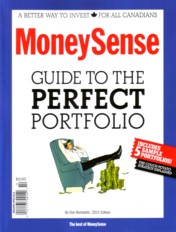

 Canadian Couch Potato is pleased to announce the birth of The MoneySense Guide to the Perfect Portfolio. My new book has just hit the shelves across Canada: look for it on the magazine stand at Shoppers Drug Mart, Walmart, Chapters/Indigo and Loblaws stores, or buy it online. At just $9.95, it’s the same price as a single ETF trading commission.
Canadian Couch Potato is pleased to announce the birth of The MoneySense Guide to the Perfect Portfolio. My new book has just hit the shelves across Canada: look for it on the magazine stand at Shoppers Drug Mart, Walmart, Chapters/Indigo and Loblaws stores, or buy it online. At just $9.95, it’s the same price as a single ETF trading commission.
The MoneySense Guide to the Perfect Portfolio is a roadmap for the do-it-yourself investor in Canada. It begins with my best attempt at laying out the case for passive investing: I explain the problems with mutual funds and active stock-picking strategies designed to beat the market, and I encourage investors to focus on the things they can control rather than basing their financial lives around the pursuit of an unlikely goal.
The next two chapters explain the importance of saving, setting targets and making a financial plan. This is an often neglected part of the investing process: it makes no sense to dwell on individual securities or funds unless you have some context for your investments. I look at the importance of gauging your risk profile and explain how you can build a portfolio that is suited to your goals.
Chapter 5 is a complete guide to choosing the most appropriate index funds or ETFs for your portfolio, while the next two give step-by-step instructions on opening a discount brokerage account and placing mutual fund and ETF orders. Many experienced investors take this stuff for granted, but it’s intimating for novices, and it’s one of the main obstacles preventing people from becoming DIY investors. I want to thank Ram from Canadian Capitalist, Michael James, and Mike from MoneySmarts for reviewing this material and offering suggestions.
The next two chapters deal with rebalancing (download my rebalancing spreadsheet to help you) and staying the course. As many index investors know, it can be difficult to stick to your plan when markets go south, so I offer some suggestions for tuning out the noise.
To put a human face on all of this, we’ve included five stories from real investors. One is Andrew Hallam, author of Millionaire Teacher , who explains why he gave up stock-picking even after a decade of tremendous success. We also hear from several other MoneySense and Canadian Couch Potato readers: my thanks to all of them for sharing their experiences as DIY index investors.
, who explains why he gave up stock-picking even after a decade of tremendous success. We also hear from several other MoneySense and Canadian Couch Potato readers: my thanks to all of them for sharing their experiences as DIY index investors.
Portfolio performance data is here at last
The final chapter of the book includes my Model Portfolios, and that leads to my next announcement. With the help of Justin Bender of PWL Capital in Toronto, I am now publishing monthly performance data for the Model Portfolios and their underlying ETFs. I’ll upload a new PDF report each month (there’s a permanent link on the Model Portfolios page) as soon as the data are available. A few important notes:
- The portfolio returns only go back to the beginning of 2011. Many of the ETFs I recommend are new, and I did not want to simulate performance using index data. It would have been nice to provide backtested three-year numbers—stock markets are up 30% to 50% since then—but that would have been dishonest. (Actual 10-year performance numbers for the Global Couch Potato using TD e-Series funds are available here.)
- All returns are expressed in Canadian dollars. Readers should find this extremely useful, as all of the publicly available performance data for the Vanguard ETFs I recommend are in US dollars.
- These are total returns, which means they include dividends and interest. This makes them far more useful than tools like Google Finance, which only graph price changes and ignore distributions.
- Trading commissions and taxes (including withholding taxes) are ignored, since they will be different for every investor.
PWL Capital has also provided a link to its own monthly market statistics, which include index data that may help you benchmark your own portfolio. Click the banner in the right-hand sidebar to access the most recent report.
Hope you’ll pick up a copy of the book, and that you’ll track your Couch Potato portfolio’s performance here on the site.












